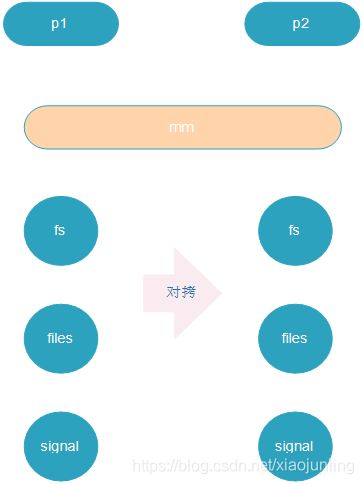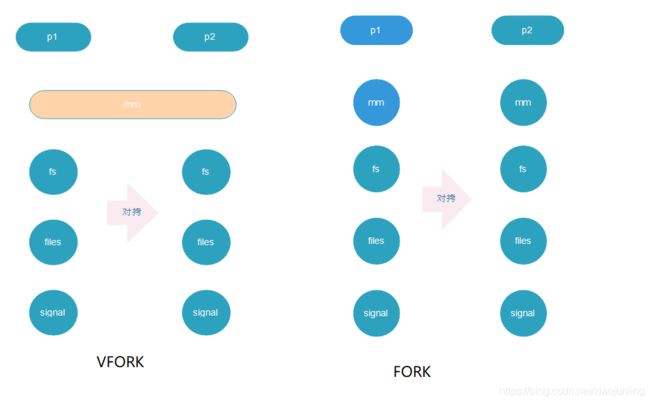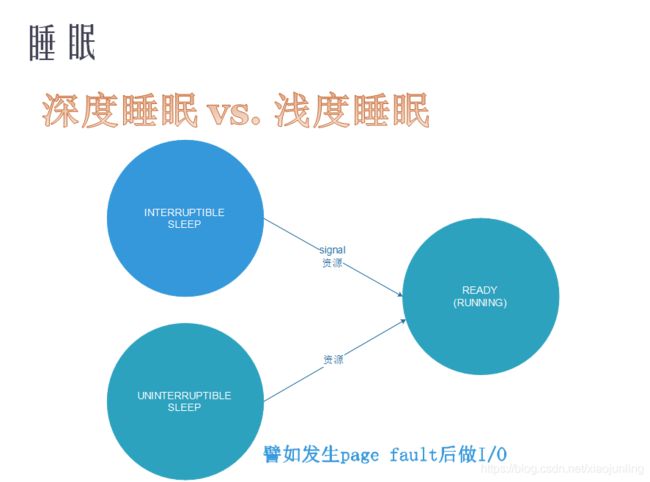Linux 进程,线程和调度 ---- 02
1. fork、 vfork、 clone
写时拷贝技术
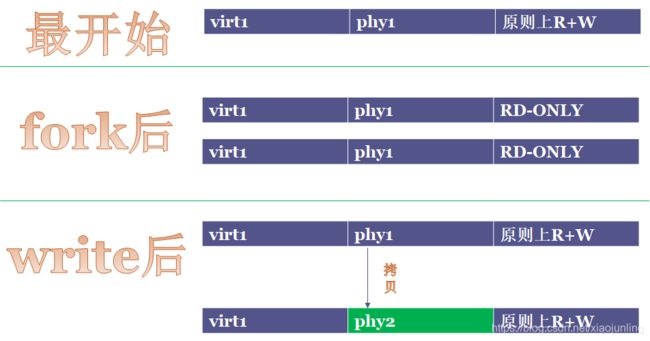
从图中可以看出,在最开始阶段的时候,就是有一个进程在运行,并且虚拟地址是可读可写的
使用fork以后产生了子进程,子进程会拷贝父进程的信息,并且共享内存资源的信息,并把相应的共享虚拟地址标记为只读的状态。
任一一个进程 write 后,写进程会申请新的物理地址,并把共享的物理地址断开,并标记为 R+W,也就是 Copy On Write (COW)机制
这是的 P1 和 P2 的虚拟地址是一样的,就是物理地址不一样
fork 以后的资源形式:
fork():
1. SIGCHLD
最难分裂的是内存资源,内存资源分配需要 MMU
vfork
在没有 MMU 的 Linux 系统中没有 fork ,只有使用 vfork
没有 Copy On Write, 没有 fork
使用 vfork : 父进程阻塞知道子进程 exit 或者 exec
vfork():
1. CLONE_VM
2. CLONE_VFORK
3. SIGCHLD
fork 和 vfork 的不同:
#include Clone
pthread_create -> clone 通过 clone_flags 传参,共享资源,可以调度的
1. CLONE_VM
2. CLONE_FS
3. CLONE_FILES
4. CLONE_SIGHAND
5. CLONE_THREAD
线程也是 LWP 轻量级进程
clone 就是创建新的 task_struct 结构体
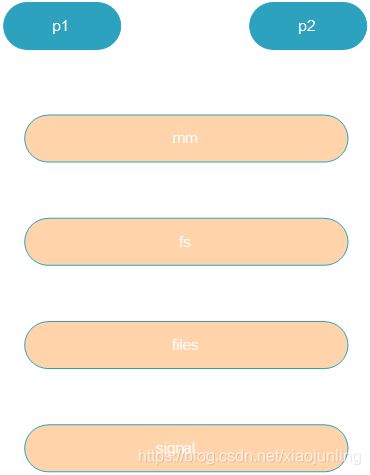
线程的 PID, POSIX 标准统一个进程穿件的线程使用同一个 PID,在内核里增加了一个 tgid (thread group ID)
// 编译 gcc thread.c -pthread, 用 strace ./a.out 跟踪其对 clone() 的调用
// ls /proc/$pid/task/ 查看 线程ID
// gettid 可以通过系统调用得到 线程ID
// pthread_self 只是拿到用户态的一个编号
#include
#include
#include
#include
#include
static pid_t gettid( void )
{
return syscall(__NR_gettid);
}
static void *thread_fun(void *param)
{
printf("thread pid:%d, tid:%d pthread_self:%lu\n", getpid(), gettid(), pthread_self());
while(1);
return NULL;
}
int main(void)
{
pthread_t tid1, tid2;
int ret;
printf("thread pid:%d, tid:%d pthread_self:%lu\n", getpid(), gettid(),pthread_self());
ret = pthread_create(&tid1, NULL, thread_fun, NULL);
if (ret == -1) {
perror("cannot create new thread");
return -1;
}
ret = pthread_create(&tid2, NULL, thread_fun, NULL);
if (ret == -1) {
perror("cannot create new thread");
return -1;
}
if (pthread_join(tid1, NULL) != 0) {
perror("call pthread_join function fail");
return -1;
}
if (pthread_join(tid2, NULL) != 0) {
perror("call pthread_join function fail");
return -1;
}
return 0;
}
2. 孤儿进程的托孤, SUBREAPER
在新的系统中不仅可以托孤给 init,也可以托孤给一个 subreaper 的进程
subreaper 进程要做一些事情
/* Become reaper of our children */
if (prctl(PR_SET_CHILD_SUBREAPER, 1) < 0) {
log_warning("Failed to make us a subreaper: %m");
if (errno == EINVAL)
log_info("Perhaps the kernel version is too old (<3.4?)");
}
PR_SET_CHILD_SUBREAPER 是 Linux 3.4 加入的新特性。把它设置为
非零值,当前进程就会变成 subreaper,会像 1 号进程那样收养孤儿进程
了
life-period例子,实验体会托孤
// 编译运行 life_period.c,杀死父进程,用 pstree 命令观察子进程的被托孤
#include 3. 进程的睡眠和等待队列
睡眠: 深度睡眠和浅度睡眠
深度睡眠: 不允许信号打断,只能通过资源来唤醒
浅度睡眠: 可以通过信号和资源来唤醒
内核里通常要等待资源时,要把 task_struct 挂载到等待队列上,资源来到时只需要唤醒等待队列就可以了
一下是进程是如何睡的,如何唤醒的
static ssize_t globalfifo_read(struct file *filp, char __user *buf,
size_t count, loff_t *ppos)
static ssize_t globalfifo_write(struct file *filp, const char __user *buf,
size_t count, loff_t *ppos)
彻底看懂等待队列的案例
/*
* a simple char device driver: globalfifo
*
* Copyright (C) 2014 Barry Song ([email protected])
*
* Licensed under GPLv2 or later.
*/
#include " );
MODULE_LICENSE("GPL v2");
4. 进程0 和 进程1
进程0 是 IDLE 进程,等没有进程运行的时候,进程0才运行,优先级是最低的,在进程0运行时会进入低功耗模式
进程1 的父进程就是 进程0

